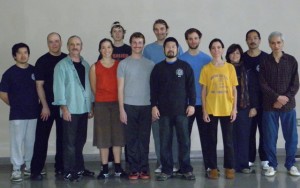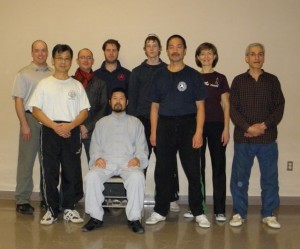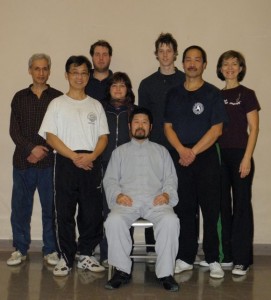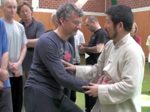Preface
I would like to thank Master Chen Zhonghua for his effort in promoting Chen Taiji in the Ottawa (渥太华) area. For the more then ten years, Master Chen has been visiting Canada’s capital to make sure that his disciples, students and other Taiji enthusiasts are training correctly, understand the concepts of the Practical Method, the theories of Taoism and aspects of Chinese culture.
Here are the notes I have made during the course of the three days seminar. Any errors in transcription or misunderstanding are solely my responsibility. My personal highlights for the seminar:
- Ultimate Secret for the beginner to succeed in the Practical Method of Chen Style Taiji!
- Monkeys?
- The Answer to “Life, the Universe and Everything” is not 42!
- Difference between external martial arts, Hsing Yi and Taij
Friday – Nov 26th – Hunyuan Qigong (混元氣功)
Master Chen taught an evening seminar at the Gilles-Vaillant Tai Chi Center (Gatineau) focusing on Hunyuan Qigong and Push Hand Drills. I did not attend this session due to prior commitment.
Saturday – Nov 27th – Foundation Exercise and the First Thirteen Moves
Ottawa Seminar took place at the University of Ottawa. In the morning, the session deal with foundation training. We start with a warm up routine of foundation exercises such as positive circles, negative circles, twist the towel and so on.
Master Chen proceeds to correct the details of each of the foundation exercise.
Some of the points to remember:
- In both the positive and negative circle. The first half of the circle:
- The vertical Line and the center does not move. (重心無偏)
- Make the shoulder disappear. (This means link the shoulder to the hip)
- Make the stomach disappear in to a line.
- In the second half of the circle:
- Make the front half of the body completely stationary.
- Use the back half of the body to move.
When perform correctly, the the positive and negative circle will follow the idea of “No Protrusion and indentation”. (戒凸凹)
Some other notes as you perform the Foundation training”:
- Find the space in the body that is not there before; continue to try to stretch along the line of action
- The aim is to achieve “waist less” which starts with the shoulder connecting to the hip and eventually the whole body disappears into the waist. Look at the Monkey, its torso its integral and therefore it can move and fall with grace.
- One of the stage of training is that the “Kua must find the Knee – the knee has to find the foot.”
In terms of general training philosophy, Master Chen explained that
- In the beginning, there is natural harmony but there is no differentiation of body parts.
- Through training in Taiji, you strive to understand the separation of different body parts.
- The goal is to achieve trained harmony. Aspects of this state includes” the core does not more, the parts can move independently.
Master Chen proceeded to lead the class in performing the first thirteen moves of Yilu. Amongst the corrections in Yi Lu are:
- In Pound the mortar (金刚捣捶), bring the left elbow in to your center line as far as possible. If this position feels awkward, then you are on the right path.
- In Block the coat (懒扎衣), as the hands open, imagine that there are three dots. Two of the dots are on the hands and one dot on the center of the back. The objective of the motion is to make the three dots as long as possible (a stretch).
- In Block the coat (懒扎衣), as you bring the elbows in, make sure that the elbows are directed to the Dan Tain (丹田) and the hands are pointed out. Remember the phrase, “The Inside infinitely small and the outside infinitely large”
After lunch, we worked on “placing the sections into the line of power”. The “Line of Power” concept is best explained in the series of DVD that Master Chen produced under the title “Energy Alignment”. In this case, Master Chen introduces a series of exercise that move the kua then the knee towards this line. The technique is to have a fix external reference point along the power line and then use a large physical action to move the kua ino this point. The next exercise is to try to move the shoulder down into the kua. The next exercise is to move the knee down into the line of power. Finally, all sections are aligned in the line of power.
The end of the day, we practiced the Foundation exercises again.
The Saturday seminar finished with the Discipleship Ceremony of Dr. Daniel Mroz and Dave Dahms. Congratulations to both Daniel and Dave on this important milestone in their training. The celebration continued with a dinner at the Dragon, a local Chinese restaurant. Master Chen continued to provide in depth insight into his training during the evening.
Sunday Nov 28th – In depth Push Hands Training
This session was focused on push hands training. We took turns practicing push hands with different partners while Master Chen provided hands on experimentation, insightful suggestions and critical comments. Amongst some of the general concepts applicable for all push hand practitioners:
- For an action to occur, you need to have an anchor.
- All power is from the leg.
- Making the top heavy is a good trick.
- Action fluctuates; Taji application is to add space and elements. For example, in attack: line up, lock, split, spiral and compression. The result is a successful technique. In defense, move in five different directions without breaking the line.
- When the inside does not move, but the outside moves; this is a rotation.
- Inside has to be open
- Connection is just a process for delivery. You can change the path but the start and the end is defined.
This represents a short summary of three days of intensive training. I would also like to take the opportunity to personally thank the organizers: Rachelle Bergeron and Dr Daniel Mroz
My personal observations
Ultimate Secret for the beginner to succeed in the Practical Method of Chen Style Taiji !
During an informal discussion, Master Chen suggested that the method and process is simple and clear but students always deviate from the prescribed method. The key to success in the Practical Method is to practice Yilu.
Of course, I asked how long should we practice. Master Chen responds that generally three years and a large number (10,000 repetition) of forms will allow the body to acquire the necessary habit to progress in Taiji.
Great news for beginners like me, I have a criteria for success. Three years, 10,000 repetition of Yilu. This is only 3333 forms a year! 64 forms a week. 9 times a day. So say on average, one performance of Yilu takes 10 minutes, this only means one hour and half of training per day!
Monkeys?
Taiji practice not only trains the body to be like monkeys by making the waist vanish. It also needs to deal with the monkey mind (xinyuan; “心猿”). This is a term used often in the Chinese Buddhist tradition and applies equally in Taiji self cultivation. Master Chen provides one illustration of the monkey mind. Often, he provides students with the instruction “Elbow in, hand out”. Students will inevitably ask about something else such as “What about the kua?”. Master Chen will repeat to emphasis that the current exercise is to work on the concept “Elbow in, hand out”, the issues of the kua is not relevant. The student will then accept this as a “non-answer”, dutifully performing the exercise according to the instructions. When Master Chen turns away, the student will ask his friends, “so what about the kua?”
The monkey mind is in everyone, through training and self-cultivation, we quiet our monkey mind.
As Master Hong said
持之恒, Persist
守規矩, Follow the rules
求進步, Seek progress
莫心急, Don’t rush
The Answer to “Life, the Universe and Everything” is not 42!
The principle of Taiji for Taoist is based on the following system:
- 1 (Unity) and Zero (Emptiness) is the same. It represents existence and non-existence.
- 2 represent a separation of the one object (Yin / Yang separation). For example, Man and woman.
- 3 represent 2 and their interactions. For example, Man and woman and their interactions which can spawn a new creation (another object, a new person). Three is the largest number representing infinity.
This concept is repeated in other situations:
- Taiji push hands states with you (1) and the opponent (2) and the action (3).
- the Yilu (81 moves) that reflects all the possible combination of the body movement and represents the Yin component.
- the Erlu (64 moves) represents the actions and represent the Yang component.
So the Answer to “Life, the Universe and Everything” is simply 1,2 3!
Difference between external martial arts, Hsing Yi and Taiji
This is an common adage in Chinese concerning the martial arts:
” 功夫三月打死牛
形意一年打死人
太极十年不出门”
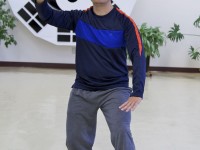 Roughly translated, the external martial arts (known as kung fu”功夫”) can train someone to kill a cow (牛) in three months (三月). The art of Hsing Yi (“形意”) can train you to kill a man in one year. You can train for ten years in Taiji before you can even walk out the door (“出门” or in a general sense “no longer a beginner”).
Roughly translated, the external martial arts (known as kung fu”功夫”) can train someone to kill a cow (牛) in three months (三月). The art of Hsing Yi (“形意”) can train you to kill a man in one year. You can train for ten years in Taiji before you can even walk out the door (“出门” or in a general sense “no longer a beginner”).
This is a good reminder of the requirement of patience and perseverance required in Taiji training.

